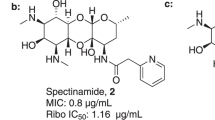Summary
Protein synthesis is catalysed by ribosomes and cytoplasmic factors. Bacterial ribosomes (70S) are made up of 2 subunits (50S and 30S) containing ribosomal RNA (rRNA) and ribosomal proteins: the 30S binds messenger RNA and begins the ribosomal cycle (initiation), whereas 50S binds transfer RNA (tRNA) derivatives and controls elongation. The key reaction, peptide bond formation, is promoted by the catalytic centre of 50S (the peptidyl transferase centre), and the growing peptide chain (peptidyl-tRNA) attached at the donor P site undergoes peptide linkage with an aminoacyl-tRNA at the acceptor A site. This reaction is inhibited by several antibiotics, the best known being chloramphenicol, and the macrolide-lincosamide-streptogramin (MLS) group. These inhibitors have a reversible action, except for streptogramins that are composed of A and B components, which are bacteriostatic alone, but bactericidal when combined.
The peptidyl transferase centre has been identified at the 50S surface, and the binding sites of inhibitors have been mapped within this domain: some of these sites overlap (e.g. those of macrolides, and type B streptogramins, which compete for binding to ribosomes). Chloramphenicol blocks the catalytic portion, and A streptogramins the substrate sites of the peptidyl transferase centre. Macrolides and type B streptogramins interfere with the formation of long polypeptides and cause a premature detachment of incomplete peptide chains. The synergism between types A and B streptogramins is due to induction by type A streptogramins of an increased ribosome affinity for type B streptogramins.
Microbial resistance to antibiotics mainly involves inactivation of inhibitors and modification of targets (mutations of ribosomal proteins or rRNA genes). Alterations of rRNA bases can induce resistance to a single inhibitor or to a group of antibiotics (e.g. MLSB). The impact of resistance in chemotherapy is less important for streptogramins than for other inhibitors, because the synergistic effect of A and B streptogramins also applies to strains resistant to the MLSB group. It is proposed that mutations and modifications of rRNA bases induce conformational ribosomal changes that prevent antibiotics binding to the target. Conformational changes are also triggered by type A streptogramins: they are responsible for their synergism with type B streptogramins.
Similar content being viewed by others
References
Cocito C. Textbook of Microbiology. Brussels: Catholic University of Louvain
Cocito C. Antibiotics of the virginiamycin family, inhibitors which contain synergistic components. Microbiol Rev 1979; 43: 145–98.
Vazques D. The streptogramin family of antibiotics. In: Corcoran JW, Hahn FE, editors. Antibiotics. Vol. 3. Heidelberg: Springer Verlag, 1975: 521–34.
Chinali G, Di Giambattista M, Cocito C. Ribosome protection by tRNA derivatives against inactivation by virginiamycin M. Evidence for 2 types of interaction of tRNA with the donor site of the peptidyltransferase. Biochemistry 1987; 26: 1592–7.
Di Giambattista M, Thielen A, Maassen J, et al. Localisation of virginiamycin S binding site on bacterial ribosome by fluorescence energy transfer. Biochemistry 1986; 25: 3540–7.
Di Giambattista M, Nyssen E, Pecher A, et al. Affinity labeling of the virginiamycin S binding site on bacterial ribosome. Biochemistry 1990; 29: 9203–11.
Cocito C. Properties of virginiamycin-like antibiotics (synergimycins), inhibitors containing synergistic components. In: Corcoran JW, Hahn FE, editors. Antibiotics. Berlin: Springer Verlag 1983; V1: 296–332
Chinali G, Vanlinden F, Cocito C. Action of virginiamycin M on the stability of different ribosomal complexes to ultracentrifugation. Biochim Biophys Acta 1988; 950: 67–74.
Lai CJ, Weisblum B. Altered methylation of ribosomal RNA in an erythromycin-resistant strain of Staphylococcus aureus? Proc Natl Acad Sci USA 1971; 68 (4): 856–60.
Moazed D, Noller HF. Chloramphenicol, erythromycin, carbomycin and vernamycin B protect overlapping sites in the peptidyl transferase region of 23S rRNA. Biochemie 1987; 69: 879–84.
Noller HF. Ribosomal RNA and translation. Ann Rev Biochem 1991; 60: 191–227.
Vannuffel P, Di Giambattista M, Morgan EA, et al. Identification of a single base change in ribosomal RNA leading to erythromycin resistance. J Biol Chem 1992; 267: 8377–82.
Vannuffel P, Di Giambattista M, Cocito C. The role of rRNA bases in the interaction of peptidyltransferase inhibitors with bacterial ribosomes. J Biol Chem 1992; 267: 16114–20.
Cundliffe E. On the nature of antibiotic binding sites in ribosomes. Biochimie 1987: 69: 863–9
Di Giambattista M, Chinali G, Cocito C. The molecular basis of the synergistic inhibitor activity of type A and B synergimycins on ribosomes. J Antimicrob Chemother 1989; 24: 485–507.
Parfait R, Cocito C. Lasting damage to bacterial ribosomes by reversibility-bound virginiamycin M. Proc Natl Acad Sci USA 1980 77: 5492–6
Nyssen E, Di Giambattista M, Cocito C. Analysis of the reversible binding of virginiamycin M to ribosome and particle functions after removal of the antibiotic. Biochim Biophy Acta 1989; 1009: 39–46.
Di Giambattista M, Nyssen E, Engelborghs Y, et al. Kinetics of binding of macrolides, lincosamides and synergimycins to ribosomes. J Biol Chem 1987; 262: 8591–7.
Cocito C, Chinali G. Molecular mechanisms of virginiamycin-like antibiotics on bacterial cell-free systems for protein synthesis. J Antimicrob Chemother 1985; 16 Suppl. A: 35–52.
Chinali G, Moureau Ph, Cocito C. The action of virginiamycin M on the acceptor, donor and catalytic sites of peptidyltransferase. J Biol Chem 1984; 259: 9563–9.
Chinali G, Nyssen E, Di Giambattista M, et al. Inhibition of polypeptide synthesis in cell-free systems by virginiamycin S and erythromycin. Evidence for a common mode of action of type B synergimycins and 14-membered macrolides. Biochim Biophys Acta 1988; 949: 71–8.
Author information
Authors and Affiliations
Rights and permissions
About this article
Cite this article
Vannuffel, P., Cocito, C. Mechanism of Action of Streptogramins and Macrolides. Drugs 51 (Suppl 1), 20–30 (1996). https://doi.org/10.2165/00003495-199600511-00006
Published:
Issue Date:
DOI: https://doi.org/10.2165/00003495-199600511-00006




